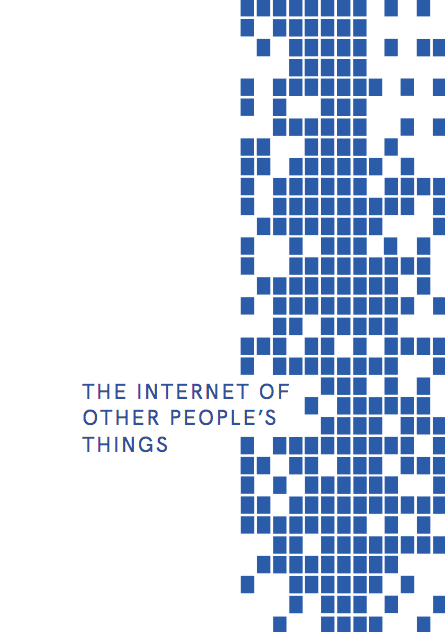Linda Kronman, Andreas Zingerle (eds.): The Internet of Other People’s Things (2018)
Filed under book | Tags: · city, data, governance, infrastructure, internet of things, urbanism

“The Internet of Things (IoT), smart city initiatives, and smart home technology are marketed to us as sleek and glamorous 3D renderings promising a convenient and sustainable technology that will save us and our planet from a future of environmental distress. Yet the buzzword bingo of smart city rhetoric, the polished advertisements for networked devices, and the glossy packaging of smart home devices are in stark contrast to the news and research which investigates the vulnerabilities of our connected lives. The expansion of the IoT and the proliferation of virtually-connected data points are providing ever increasing amounts of information for those keen on use or abuse. The massive implementation of IoT in hyper-connected urban environments, paths the way to technocratic governance and urban development, corporatizing our living spaces into lock-in, hack-able, “pan optic” smart cities. The IoT seems to develop towards an Internet of Other People’s Things (IoOPT), where users do not own their data, agree to Terms of services that mean their data are then shared by default to third parties, and the risks that citizens rights are managed by technocratic governance or cyber criminals attacking critical infrastructures are always present.
In this cyberwar of ideas, an asymmetric battle for power and influence, systems will have to be more robust and people will have to be more vigilant. Therefore we turned to the community of artists, designers, activists, hackers and researchers with an open call for new critical perspectives on ubiquitous technology and its impact on our lifestyle. We were looking for projects that abuse to expose; artistic research and tacit knowledge that is produced through cultures of making, hacking, and reverse engineering. Our aim was to collect artworks, projects, essays, and interviews discussing questions such as: What does privacy look like in a smart home of connected objects? How are citizens involved in co-design collaborations with private corporations and the public sector to build better cities? How can we enable a secure and trustworthy Internet communication so that business, personal, and machine-to-machine interactions can be conducted safely and without interference?”
Publisher servus.at, Linz, 2018
Creative Commons BY-SA 4.0 International License
ISBN 9783950420012
235 pages
Ravi Sundaram: Pirate Modernity: Delhi’s Media Urbanism (2009)
Filed under book | Tags: · city, delhi, globalisation, infrastructure, mass media, modernism, modernity, piracy, postcolonialism, urban planning, urban studies, urbanism

“Using Delhi’s contemporary history as a site for reflection, Pirate Modernity moves from a detailed discussion of the technocratic design of the city by US planners in the 1950s, to the massive expansions after 1977, culminating in the urban crisis of the 1990s.
As a practice, pirate modernity is an illicit form of urban globalization. Poorer urban populations increasingly inhabit non-legal spheres: unauthorized neighborhoods, squatter camps and bypass legal technological infrastructures (media, electricity). This pirate culture produces a significant enabling resource for subaltern populations unable to enter the legal city. Equally, this is an unstable world, bringing subaltern populations into the harsh glare of permanent technological visibility, and attacks by urban elites, courts and visceral media industries. The book examines contemporary Delhi from some of these sites: the unmaking of the citys modernist planning design, new technological urban networks that bypass states and corporations, and the tragic experience of the road accident terrifyingly enhanced by technological culture. Pirate Modernity moves between past and present, along with debates in Asia, Africa and Latin America on urbanism, media culture, and everyday life.
This pioneering book suggests cities have to be revisited afresh after proliferating media culture. Pirate Modernity boldly draws from urban and cultural theory to open a new agenda for a world after media urbanism.”
Publisher Routledge, Oxford & New York, 2009
Asia’s Transformations series
ISBN 9780415409667, 0415409667
xix+224 pages
HT Geraldine
Reviews: Diya Mehra (SAMAJ, 2011), Fei An Tjan (Masters of Media, 2010).
PDF (10 MB)
Comment (0)The Funambulist by its Readers: Political Geographies from Chicago and Elsewhere (2019)
Filed under book | Tags: · architecture, chicago, city, geography, politics, space, urbanism

“Initiated in 2015 as a print and online magazine, The Funambulist does not understand architecture as the authored design of inhabitable sculptures, but rather as the discipline that organizes bodies in space. With such a perspective, we have attempted to detach ourselves from architecture as a discipline and have focused instead on formulating spatial approaches to anti-colonial, anti-racist, anti-capitalist, queer, trans, feminist, anti-ableist political struggles and that against which they fight.
For this book commissionned by the Chicago Architecture Biennial 2019, we have invited 20 regular readers (many of whom are also contributors) of The Funambulist to pick, among the many texts we published in our 22 first issues, the one that appeared to them as the most politically useful. We are republishing these texts here, as well as their introductions, written by these 20 guests.
In addition to this, we asked five Chicago-based activists to write about the spatial politics of their city in relation to settler colonialism, the municipality, the police, the real estate pressure, as well as the school system. At a crucial moment following the change of administration, this appeared to us as the most politically useful thing we could do to propagate the voices of those active on the ground.”
Edited by Léopold Lambert, et al.
Publisher The Funambulist, Paris, Sep 2019
Open access
ISBN 9782956935803
234 pages
PDF (34 MB)
Comment (0)
